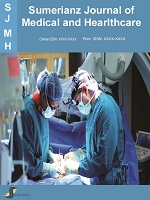Sumerianz Journal of Medical and Healthcare

Online ISSN: 2663-421X
Print ISSN: 2706-8404
Quarterly Published (4 Issues Per Year)
Journal Website: https://www.sumerianz.com/?ic=journal-home&journal=31Archive
Volume 3 Issue 6 (2020)
Assessment of Peri-Donation Undesirable Events among Voluntary Non-Remunerated Blood Donors: Experience at a Private Blood Banking and Donor Recruitment Centre in Benin City, Edo State, Nigeria
Authors : Nwagu Marcellinus Uchechukwu ; Ikusemoro Augustina Isioma ; Adeyemi Oluwafemi
Abstract:Background: There has been an increasing blood shortage in sub-saharan Africa. Much progress has not been made in voluntary blood donation and retention of blood donors. This makes availability of safe blood in our blood banks very difficult. Undesirable events during blood donation are some of the reasons that would discourage blood donors from coming back to donate again. This study was aimed at determining the prevalence and make assessment of these adverse events. Methods: This was a cross-sectional study carried out for a period of 11months at a private blood banking facility in Benin City, Nigeria. Semi–structured and pre-tested questionnaire was used to collect vital information from consenting respondents. The data collected was analyzed using SPSS software version 23. Approval for this study was granted by Research Ethics Committee, Faculty of Clinical Sciences, Edo University, Iyamho. Results: A total of 2,229 people donated blood during the study period. Forty-seven had blood donation adverse events giving a prevalence of 2.1%. The mean age was 24.15+6.74 years. Females were 74.5% while males were 25.5%. The adverse events were dizziness (70.2%), Fainting (17.0%), weakness (8.5%) and vomiting (4.3%). Conclusion: The prevalence of adverse events is low in a private blood bank facility similar to public institutions. The adverse events were mainly mild complaints due to vasovagal reactions. We recommend more counselling sessions and other modalities to allay the fears of potential blood donors.
Evaluation of Deaths Cases Due To Traffic Accidents in the Pediatric Age Group
Authors : Erel O. ; Yigit P. ; Çitak Akbulut A.
Abstract:Background: In this study, it was aimed to analyze the traffic accidents in pediatric age group with postmortem examinations and autopsies. Methods: 35 traffic accident reports were sought from forensic autopsy performed in 64 pediatric age groups. External examination / autopsy reports of selected cases were examined retrospectively and demographic characteristics of dead cases, accident location, accident type, type of vehicles involved in the accident, year, season, day and accident time, victims’ position in traffic, orthopedic and internal organ injuries, autopsy whether it was done, the cause of death, the place of death and the time of death were evaluated. Results: Among the 64 forensic death cases in pediatric age group, observed cause of death was determined to be traffic accidents in 35 (55%) cases. Male cases accounted 66%, and male to female ratio was 2:1. From the reports, 48.6% of the accidents happened in summer and most commonly sunday (22.9%). In 48% of accidents, the cause of death was head trauma. Moreover, it was determined that the most injured person was the pedestrian. Automobiles took the lead in the causes of the traffic accidents. Conclusion: Considering the increase of accidents in July and Sunday, when schools are holidays; It is important to review traffic education for children, increase traffic controls and be more careful about parents.



